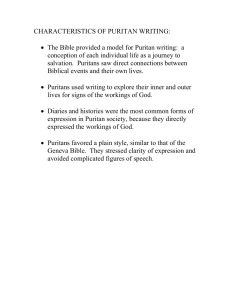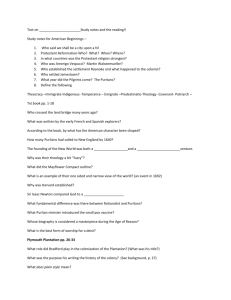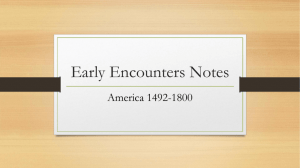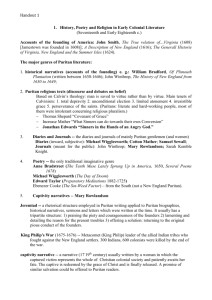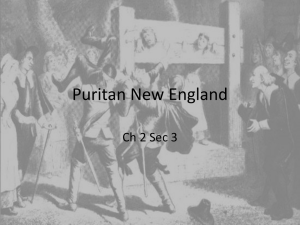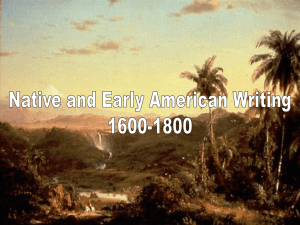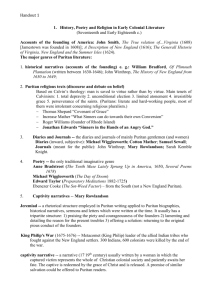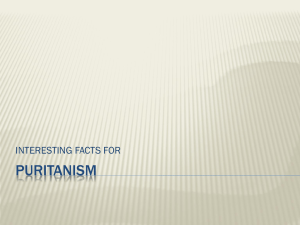Introduction to Puritan Literature Notes
advertisement
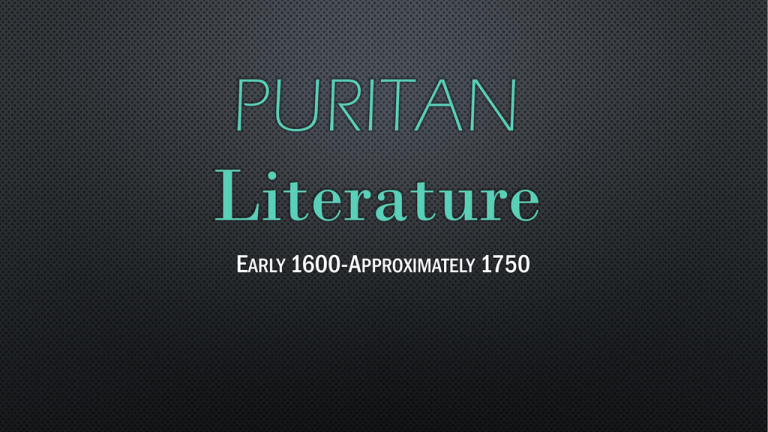
PURITAN Literature EARLY 1600-APPROXIMATELY 1750 The Puritan Legacy • Puritan: broad term referring to a number of Christian Protestant groups who sought to “purify” the Church of England • Persecuted for beliefs and fled England for Holland and, ultimately, North America • First English Puritans landed in 1620 • Tip of Cape Cod • Just before Christmas Puritan Values • Single-minded visionaries convinced of the rightness of their beliefs • Very practical and businesslike • Simple way of life with few possessions • Many historians feel Puritan ethics of thirst, hard work, and selfsufficiency contributed to the success of the New World • Could be why the U.S. became such a hardworking nation and leader in the world HOW IS THE PROTESTANT WORK ETHIC STILL EVIDENT IN AMERICANS’ LIVES TODAY? WHAT ARE SOME EXAMPLES? Puritan Beliefs • All people were sinners • Emphasized that hard work not only produces wealth, but also strong moral character • Reading the Bible was a necessity for all Puritans • For this reason, they were very literate • Believed in the “elect”—a group of people who would be saved and go to Heaven • Predestination—already determined by God • Difficult to know for certain if one were part of the “elect” • Good behavior was a sign of being “elect” • Scrutinized daily lives and behavior for signs that they were part of the “elect” Puritan Literature • Bible provided a model • Direct connections between Biblical events and their lives • Used writing to explore and scrutinize their inner and outer lives for signs of the working of God • Diaries and histories were most common forms of expression • Described feeling/experiences in daily life • Frowned on creative expression Puritan Literature • Genres that the Puritans Favored: • Sermons (Sinners in the Hands of an Angry God, Jonathan Edwards) • Religious poetry (“Upon the Burning of Our House” and “To My Dear and Loving Husband” by Anne Bradstreet) • Historical narratives (The Captivity of Mary Rowlandson) • Journals (Of Plymouth Plantation by William Bradford) • Literature was not for entertainment. Novels and plays were frowned upon due to the perceived lack of practical religious value. Values in Puritan Literature • Predestination—signs of salvation • Strong work ethic • Literacy and education • Community effort not individualism • Man’s inherent sinfulness • God’s omnipotence • Wilderness as the devil’s province • Saw nature as God’s creation but feared disorder of the frontier • Viewed native Americans as savages Characteristics of puritan Literature • Favored plain style: • Short words, direct statements, references to ordinary objects • Thought God’s workings were to be found in everyday things and events • Stressed clarity of expression and avoided complicated figures of speech • Believed anything that appealed to senses or emotions was too worldly and dangerous. • Apostrophe-figure of speech in which a speaker directly addresses a person who is dead or not physically present, a personified object, a nonhuman thing, or an abstract idea. • Example • Writing a poem to the sky • Writing a poem to your long-lost first pet OF PLYMOUTH PLANTATION WILLIAM BRADFORD IN THE MOST BORING AND SLEEP-INDUCING STYLE POSSIBLE, DESCRIBE THE MOST AMAZING, EXCITING, AWESOME, MINDBLOWING (SCHOOL APPROPRIATE) THING THAT HAS EVER HAPPENED TO YOU. DICTION: THE CHOICE OF WORDS USED BY A WRITER. *MINIMUM 250 WORDS* OF PLYMOUTH PLANTATION • Plain style • Diction • Author’s word choice • Plain style simply means that Bradford’s diction is not fancy or ornamental and is not intended to be showy. Why? • This falls in line with the Puritan belief that one should not call attention to oneself. • This is the opposite of Shakespeare, whose writing in England was very showy and meant to showcase his skill as a writer. OF PLYMOUTH PLANTATION WILLIAM BRADFORD A NARRATIVE OF THE CAPTIVITY OF MRS. MARY ROWLANDSON A NARRATIVE OF THE CAPTIVITY OF MRS. MARY ROWLANDSON • By 1665 there were approximately 25,000 Puritans in Massachusetts Bay Colony. • The Wampanoag Indians were starving and displaced from their land. • Angered by the Puritan execution of three Wampanoag, Massosoit’s son, Chief Metacomet (called King Philip by the Puritans) led a revolt in 1675 and kidnapped Puritans in order to get ransom money for much-needed supplies and food. A NARRATIVE OF THE CAPTIVITY OF MRS. MARY ROWLANDSON A NARRATIVE OF THE CAPTIVITY OF MRS. MARY ROWLANDSON • Tone: a writer's or speaker’s attitude toward the subject matter. A writer’s tone might convey a variety of attitudes such as sympathy, humor, or anger. • After reading her story, how would you describe Rowlandson’s tone in this personal narrative? • What are some words she uses to communicate her tone? “TO MY DEAR AND LOVING HUSBAND” “UPON THE BURNING OF OUR HOUSE” ANNE BRADSTREET ANNE BRADSTREET • The first American poet • Wrote her poems while raising 8 children “on the edge of wilderness.” • Her poems combined domestic details of her daily life and spiritual details of her religious life. • Writing was considered an unsuitable occupation for women at the time, and she assured her readers she did not avoid her domestic responsibilities to write poetry. “UPON THE BURNING OF OUR HOUSE” • Inversion: changing the usual order of words in order to maintain the rhyme scheme and rhythm of the poem. • Example: “For sorrow near I did not look” instead of “I did not look nearby for sorrow” • Metaphor: a figure of speech that compares two things by saying that one this is another. An extended metaphor develops a metaphor by adding more details. • Narrative poem: a poem that tells a story. A narrative poem has characters, conflict, and plot; all of the necessary components of a story. “TO MY DEAR AND LOVING HUSBAND” • Couplet: two consecutive rhymed lines of poetry • Example: “I prize thy love more than minds of gold Or all the riches that the East doth hold.” • Lyric poem: a poem that expresses the thoughts and feelings of the speaker. A lyric poem does not tell a story. “TO MY DEAR AND LOVING HUSBAND” “UPON THE BURNING OF OUR HOUSE” ANNE BRADSTREET “SINNERS IN THE HANDS OF AN ANGRY GOD” JONATHAN EDWARDS “ “I think it is a reasonable thing to fright persons away from hell…is it not a reasonable thing to fright a person out of a house fire?” Jonathan Edwards ” JONATHAN EDWARDS (1703-1758) • Known for his “preaching of terror.” • Calvinist: preached that God was all-powerful and humans had no free will • Believed in predestination • Sinners in the Hands of an Angry God was first preached on July 8, 1741. EMOTIONAL APPEALS • Appeal to fear: designed to persuade by invoking fear though threatening people’s safety or happiness if they make the wrong choice. • Edwards uses vivid imagery and similes and metaphors to scare his audience into being saved. • Limited time offer: buy this product (or make the decision to believe in God) now because it is only offered for a short time (or you might die today and go to Hell!). • Bandwagon: “All of your friends are doing it, so you should, too!” “SINNERS IN THE HANDS OF AN ANGRY GOD” JONATHAN EDWARDS YOUR PERSUASIVE APPEAL • You want to persuade someone (a parent, friend, teacher, coach, etc.) to make a certain decision. • In a one-page, hand-written speech, use vivid imagery and the three emotion appeals we have discussed today to persuade your audience. • Highlight or underline each appeal and identify it the margin of your paper. • You may want to use similes or metaphors that appeal to your audience’s deepens fears, as well. PERSUASIVE Speech POSSIBLE TOPICS • Don’t text while driving • Don smoke or dip • Work hard in school and graduate • Give me more playing time • Buy me a new car • Go on a Date with me or don’t date this guy or girl **Remember: all appeals must be based on emotion only!** HOW DID RELIGION SHAPE THE LITERATURE OF THE PURITAN PERIOD? • Using your notes and your knowledge of what we’ve read and discussed in the unit, answer the above question • Answer in complete sentences, and use specific examples from your notes HOW DID RELIGION SHAPE THE LITERATURE OF THE PURITAN PERIOD? • Religious Values were put above all else in every area of these people’s lives. • This led to a focus on practical literature (sermon, historical narratives, journals, and poetry with a spiritual message). • This also led to a certain style of writing that mirrored the Puritans style of living (plain style) • Themes were religious in nature and reflected Puritan values.
